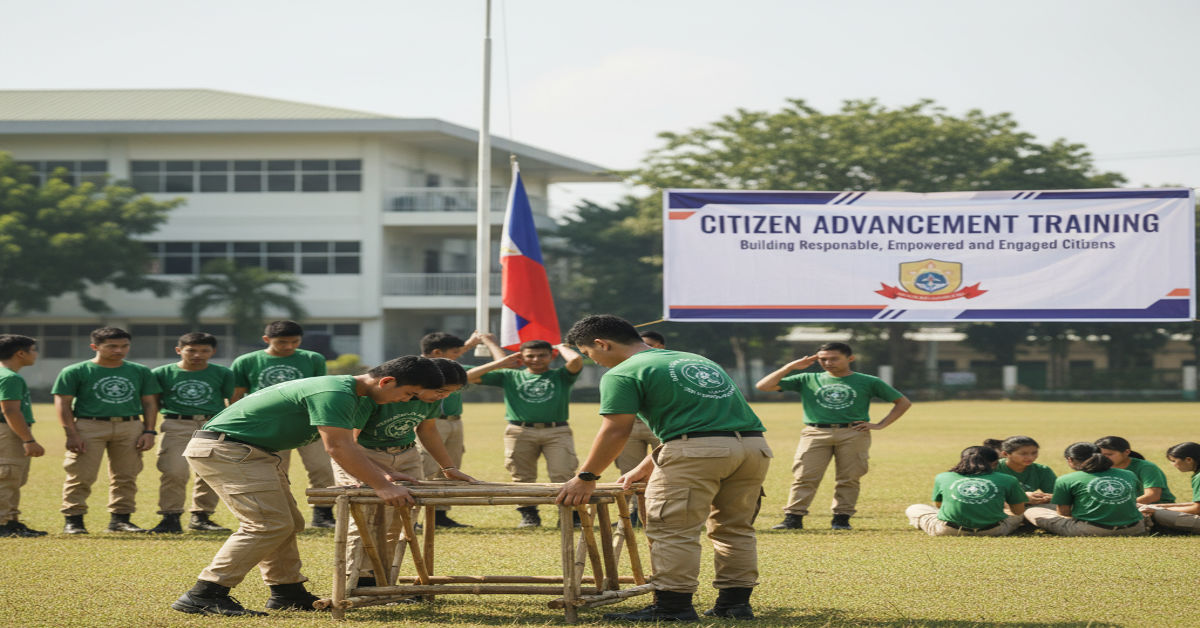Citizen advancement training is a forward-thinking approach to developing socially aware, responsible and action-oriented citizens. It prepares individuals—especially the youth—to contribute meaningfully to their communities through civic knowledge, ethical responsibility, leadership, and service. In an era when civic engagement is often overshadowed by social media noise and political apathy, programs like these help revive the essence of active citizenship. They create individuals who understand their rights and duties think critically about societal issues and act with empathy and accountability.
Governments, educational institutions, and civic organizations worldwide are recognizing that informed citizenship doesn’t arise spontaneously. It must be nurtured through systematic education and experience. According to UNESCO, quality citizenship education is essential for sustaining democratic values, tolerance, and human rights. Citizen advancement training aligns with this vision, translating civic ideals into concrete learning experiences that inspire long-term social responsibility.
Understanding Citizen Advancement Training
Citizen advancement training (CAT) can be defined as a structured program designed to cultivate civic awareness, leadership, moral discipline, and public service among learners. While its format varies by country, its goal remains consistent—to develop citizens capable of participating intelligently and actively in democratic processes. Unlike traditional civic education that focuses mainly on theory, CAT combines classroom instruction with community-based projects and experiential learning. Participants learn not only what civic responsibility means but also how to live it.
At its heart, CAT blends education, discipline, and community service. It might include modules on leadership, environmental awareness, safety preparedness, and national identity. Harvard University’s Civic Engagement Center emphasizes that experiential learning builds the skills needed for cooperation and social innovation. In that sense, citizen advancement training doesn’t just shape character—it builds the capacity to solve real problems through collaboration and empathy.
| Dimension | Description | Desired Outcome |
| Civic Literacy | Understanding rights, duties, laws, and institutions | Informed participation in democracy |
| Leadership | Developing initiative and accountability | Competent and responsible leaders |
| Service Orientation | Engaging in volunteer or community projects | Stronger social bonds |
| Ethical Values | Building integrity, respect, and empathy | Moral citizenship |
| Preparedness | Training for emergencies and safety | Resilient and responsive citizens |
Historical Roots and Global Evolution
Citizen advancement training has evolved from earlier national service and civic education initiatives. In the mid-20th century, many nations introduced structured citizenship programs to reinforce national unity and discipline, particularly after periods of war or colonial transition. Over time, the focus shifted from defense and nationalism to participatory governance and community building. Modern CAT programs now emphasize peace, sustainability, and inclusivity rather than militaristic drills.
Globally, programs aligned with CAT principles exist under various names. For example, OECD member countries integrate civic competency frameworks into secondary education to prepare students for global citizenship. The EuropeanCommission’s Education and Training Strategy also highlights civic engagement as a key life skill for 21st-century learners. The transformation from obedience-based instruction to empowerment-based learning reflects a global consensus: effective citizenship is rooted in understanding, dialogue, and collaboration, not compulsion.
| Era | Focus | Learning Approach | Impact |
| 1950s–1970s | National identity and discipline | Military drills, patriotic education | Loyalty and obedience |
| 1980s–1990s | Civic awareness and service | Classroom instruction, volunteer projects | Basic community engagement |
| 2000s–Present | Leadership and social innovation | Experiential learning, digital literacy | Active, informed participation |
Core Principles and Objectives
The guiding principles of citizen advancement training rest on empowerment, inclusivity, and lifelong learning. It aims to help individuals see themselves as both beneficiaries and stewards of the public good. Participants learn to balance rights with responsibilities, cultivate empathy, and appreciate diversity. These principles align closely with the United Nations’ Sustainable Development Goal 4.7, which promotes education for sustainable development, global citizenship, and human rights.
The primary objectives of CAT are multi-layered. First, it fosters civic consciousness by helping individuals understand social systems and their role in them. Second, it develops leadership and collaboration skills needed to initiate change. Third, it strengthens ethical behavior and accountability. Finally, it encourages community service that improves collective well-being. By linking learning to real-world outcomes, citizen advancement training creates the conditions for enduring civic engagement.
| Objective | Practical Expression | Long-Term Benefit |
| Civic Awareness | Study of governance, rights, and law | Increased political literacy |
| Leadership | Team projects, mentoring roles | Future community leaders |
| Ethics | Reflection and role-playing | Responsible social behavior |
| Service | Outreach, environmental work | Improved community welfare |
Key Components and Curriculum Framework
A strong citizen advancement training curriculum includes both academic and practical components. The theoretical sections often cover national history, government structure, and civic duties. The practical side immerses learners in real projects—environmental clean-ups, disaster preparedness exercises, leadership camps, or literacy drives. These experiences transform abstract lessons into tangible action. As World Bank research shows experiential learning significantly increases problem-solving and teamwork skills.
The framework of CAT is typically modular, allowing flexibility for schools or organizations. A balanced curriculum might allocate sessions for civic literacy, ethical formation, community engagement, and physical preparedness. The integration of reflection and feedback ensures that participants internalize what they learn. A vibrant program blends education with empathy, discipline with creativity, and structure with initiative.
| Module | Core Topics | Typical Activities |
| Civic Foundations | Constitution, governance, rights | Debates, guest lectures |
| Leadership and Teamwork | Conflict resolution, project planning | Group tasks, simulations |
| Service Learning | Environmental, health, education projects | Fieldwork, volunteer drives |
| Safety and Preparedness | First aid, disaster awareness | Drills, rescue simulations |
| Ethics and Reflection | Values formation, integrity | Journaling, group reflection |
Models of Implementation Across Contexts
Citizen advancement training can be adapted to different contexts, from schools to local government programs. In formal education, it may appear as a graded subject or a co-curricular activity. In communities, it can function as a youth engagement or adult development initiative. The choice of model depends on available resources, cultural context, and target audience. Blended models that combine online learning with community work are now gaining traction for their flexibility.
Different nations have developed unique implementation strategies. In some Southeast Asian countries, CAT is embedded within secondary education, while in Nordic states it forms part of life-skills education. According to OECD’s Global Competence Framework, programs that integrate civic skills into multiple subjects yield better long-term outcomes. Effective models ensure participants not only gain knowledge but also practice civic engagement in real scenarios.
| Model | Description | Best Application |
| School-Based | Integrated within curriculum | Youth formation |
| Community-Led | Local government or NGO-run | Adult learning and inclusion |
| Hybrid | Online + field activities | Remote or diverse populations |
| National Service-Linked | Tied to volunteer or defense initiatives | Post-secondary engagement |
Stakeholders and Their Collaborative Roles
Citizen advancement training flourishes when stakeholders work in synergy. Governments provide policy direction, educators deliver instruction, communities offer venues for engagement, and youth serve as active participants. Public-private partnerships enhance reach and quality, while academic institutions ensure intellectual rigor. According to UNESCO’s Global Citizenship Education report, collaboration among sectors multiplies the social impact of civic initiatives by aligning objectives and pooling expertise.
Each stakeholder brings a unique strength. Government agencies ensure sustainability and legitimacy. Schools provide structure and mentorship. Non-governmental organizations contribute innovative practices and community ties. Local leaders and parents offer context and moral support. This cooperative framework turns citizen advancement training into a community-wide project rather than a school-bound subject.
| Stakeholder | Contribution | Key Outcome |
| Government | Policy, funding, oversight | Program sustainability |
| Schools | Delivery and mentoring | Educated and disciplined youth |
| NGOs | Community mobilization | Inclusive participation |
| Parents | Moral guidance | Value reinforcement |
| Youth | Active participation | Empowered citizens |
Educational and Societal Benefits
Citizen advancement training yields benefits that extend far beyond the classroom. Educationally, it enhances students’ comprehension of governance, law, and human rights while fostering teamwork, critical thinking, and communication skills. Programs emphasizing community service also improve motivation and attendance, as learners see tangible results from their efforts. The World Economic Forum’s Future of Jobs Report notes that social and emotional learning is now as vital as technical skill, reinforcing CAT’s holistic approach.
Socially, CAT creates ripple effects within communities. Graduates often volunteer, advocate for civic causes, and lead community projects. It promotes unity in diversity by encouraging cooperation among people of different backgrounds. Long-term, it strengthens democratic culture and social cohesion. Communities that invest in citizen advancement training often experience higher civic participation rates and greater resilience during crises.
| Category | Immediate Benefit | Long-Term Impact |
| Educational | Improved civic knowledge | Lifelong civic literacy |
| Personal | Enhanced leadership and confidence | Career readiness |
| Social | Greater volunteerism and unity | Cohesive communities |
| Institutional | Transparent local governance | Accountable systems |
Barriers and Common Challenges
Despite its advantages, implementing citizen advancement training can be challenging. Some schools face limited budgets, insufficient teacher training, or a lack of instructional materials. Others struggle to sustain interest once the initial excitement fades. Programs that rely heavily on rote methods risk turning civic education into routine compliance rather than genuine engagement. According to OECD Education Insights, experiential learning requires not just curriculum reform but also professional development for educators.
Another barrier is the misconception that CAT is purely disciplinary or militaristic. Without proper communication, communities might misunderstand its intent. Resource disparities between urban and rural schools also create uneven outcomes. The solution lies in inclusive planning, contextual adaptation, and continuous feedback from participants. Programs thrive when they balance structure with flexibility and ensure that participants feel ownership of their learning journey.
| Challenge | Underlying Cause | Possible Solution |
| Lack of funding | Limited government budgets | Public-private partnerships |
| Inadequate training | Teachers unprepared | Capacity-building workshops |
| Misconceptions | Poor communication | Awareness campaigns |
| Inequality | Resource gaps | Adaptive curriculum design |
Strategies and Best Practices for Success
Successful citizen advancement training depends on strategic design and implementation. Programs that begin with a clear needs assessment tend to be more relevant and sustainable. Schools and communities should collaborate to identify civic gaps and local issues. Learning must be experiential, allowing participants to apply theory in authentic settings. Continuous reflection sessions help translate experience into understanding. Harvard’s Project Zero emphasizes that reflection is what transforms experience into deep learning.
Sustainability is another key. Embedding CAT into national education frameworks ensures continuity beyond political cycles. Regular evaluation and flexible curricula allow the program to evolve with social changes. Nonpartisanship and transparency must be upheld to maintain credibility. When participants see tangible results—cleaner parks, informed neighbors, safer streets—they internalize the value of citizenship as both a right and a duty.
| Strategy | Description | Expected Result |
| Needs Assessment | Identify community priorities | Relevant curriculum |
| Experiential Learning | Hands-on civic projects | Deep engagement |
| Reflection & Feedback | Ongoing evaluation | Improved retention |
| Transparency | Nonpartisan delivery | Public trust |
| Sustainability Planning | Institutional integration | Long-term continuity |
Case Studies and Real-World Applications
Several countries have successfully implemented citizen advancement training in diverse forms. In Southeast Asia, for example, national education systems integrate citizenship modules into secondary schools to strengthen leadership and community service. Evaluations show improvements in civic knowledge, discipline, and collaboration. Similarly, Finland incorporates civic competencies into everyday subjects, producing students who score among the highest globally in civic literacy, as reported by OECD’s PISA studies.
At the community level, local governments often partner with civil society groups to train youth in disaster response, environmental protection, or voter education. These initiatives prove that citizen advancement training doesn’t need grand budgets to be impactful—it thrives on commitment and collaboration. When participants see themselves as co-creators of progress rather than passive learners, civic responsibility becomes a lived experience.
| Country | Implementation | Key Outcome |
| Philippines | High-school CAT integrated into curriculum | Leadership and discipline |
| Finland | Civic education across subjects | High civic literacy |
| Kenya | Community volunteer networks | Enhanced local resilience |
| Canada | Youth civic labs and mentorship | Innovation and participation |
Monitoring, Evaluation and Impact Assessment
Monitoring and evaluation are vital for maintaining quality and accountability in citizen advancement training. Programs should measure not only knowledge gained but also changes in behavior and community engagement. Pre- and post-assessments, reflective journals, and community feedback sessions are effective tools. According to the World Bank’s Education Global Practice, evidence-based evaluation ensures that resources are used efficiently and that results guide improvement.
Impact assessment should capture both quantitative and qualitative outcomes. Quantitative data—such as participation rates and project completion—provide measurable proof of success. Qualitative insights—such as testimonies or social observations—reveal deeper cultural shifts. Sharing these findings transparently builds stakeholder confidence and attracts continued support.
| Indicator | Measurement Tool | Frequency | Responsible Body |
| Knowledge gain | Pre/post tests | Start and end | Trainers |
| Behavior change | Surveys, focus groups | Quarterly | Program coordinators |
| Community impact | Project reports | Ongoing | Local partners |
| Sustainability | Alumni tracking | Annual | National office |
Conclusion and Call to Action
Citizen advancement training is more than a program—it is a social investment. It nurtures active citizens who can think critically, act responsibly, and lead with compassion. As societies face complex challenges—from climate change to inequality—the need for civic competence has never been greater. By embedding this training in education systems and communities, nations can cultivate a generation of problem-solvers ready to uphold democratic values and drive sustainable progress.
Institutions and policymakers must now treat citizen advancement training as a cornerstone of national development. Schools, local governments, and civic organizations can start small: form partnerships, conduct pilot programs, and celebrate community success stories. When citizens understand their shared responsibility, societies become stronger, fairer, and more united. Investing in civic development is, ultimately, investing in the future of democracy itself.
FAQ Section
Q1: What age group is ideal for citizen advancement training?
It is most effective for adolescents and young adults, as this stage of life shapes long-term habits and values. However, adults can also benefit from refresher programs that reinforce civic responsibility.
Q2: Is citizen advancement training only for schools?
No. It can be adapted for communities, workplaces, and organizations. The principles of civic awareness, leadership, and service are relevant in every environment.
Q3: How can digital tools enhance CAT programs?
Online platforms can support webinars, collaborative projects, and digital storytelling, making civic education more accessible and engaging, particularly for remote learners.
Q4: How do we ensure neutrality in citizen advancement training?
Maintaining nonpartisan content, involving diverse stakeholders, and focusing on universal civic values ensure that the training remains balanced and credible.
Q5: What are simple steps to start a CAT initiative?
Begin with a community needs assessment, form a partnership with local schools or NGOs, design a pilot module, and evaluate results to guide expansion.







